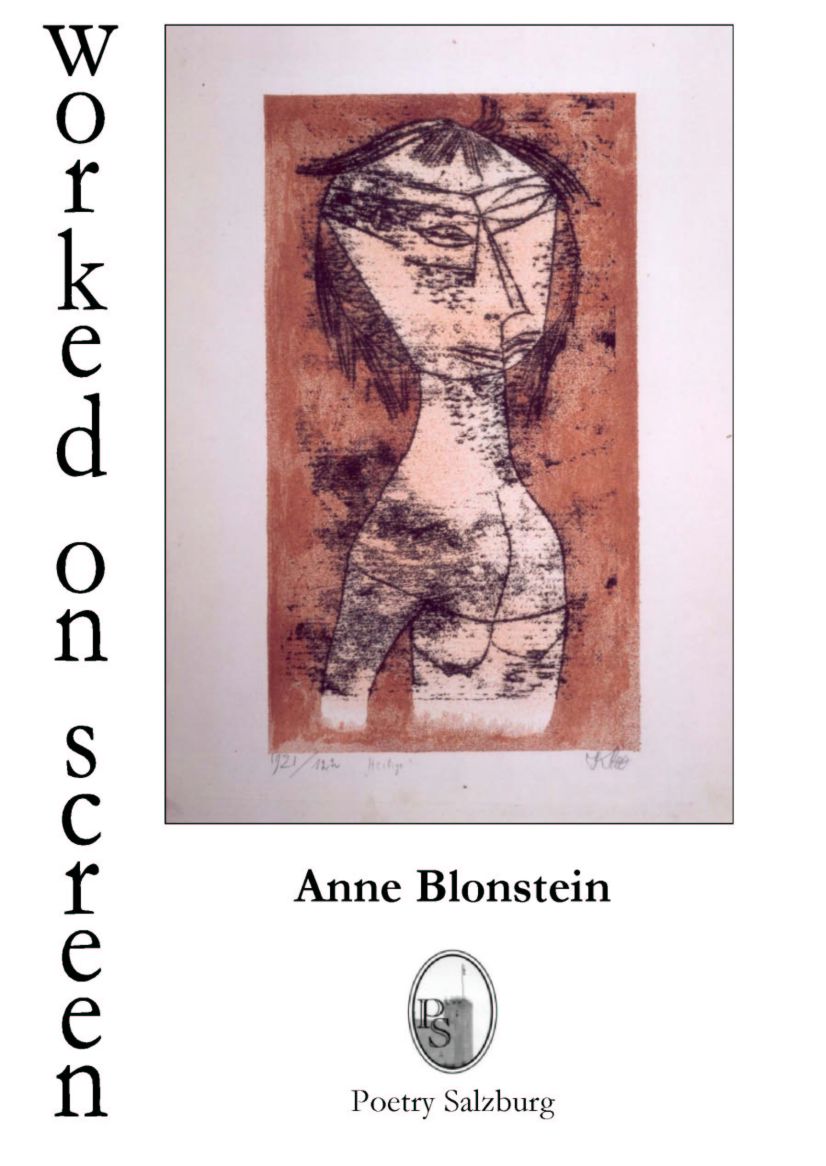 | Anne Blonstein
worked on screenJanuary 2005. 128 pp. ISBN-13 978-3-901993-18-3; ISBN-10 3-901993-18-5
£10.50 (+ 2.00 p&p), €11.00 (+ 2.00 p&p), US$ 13.00 (+ 3.00 p&p)
Beyond the encoding and decoding operation of the poems, they can be read as examples of recognised experimentallybased procedures. The use of portmanteau words, ellipses, and neologisms is particularly evident in this collection.[...] Blonstein's acknowledgement of the hermeneutical possibilities of non-lineal reading is to be welcomed. Jeffrey Side, "Linguistically Challenging?", Acumen 52 (May 2005), 103-104
Anne Blonstein [...] is skilful in the deploying of other texts within the poetry of the blue pearl.[Her] major theme throughout the collection is the relationship between shard and artefact,actual gap and imagined completeness - these borrowed elements remain discrete. What does bind themtogether is a sculptural sense of placing on the page; and, although at times it can make the workseem rather obviously structured, at its best it creates a vibrant tessellation, wholly fitting the content to the form. Stuart Kelly, "Poetry Chronicle II", Poetry Review 93.3 (Autumn 2003)
|
Order copies of worked on screen via PayPal
Excerpts from worked on screen
30.
Limb and name decomposing
she corrupts her
amputative forms tremble
like incurably cold hands - stilled through almost
touch if she could here
1917, 162//31.v.2002
98.
extinguishing i take the objects' rims
i have decorated these precioused
now deborah ascends to sarah's room
shutterproofed and unbreakable i'm
to me i slip like the others
under their appearances
extinguished i turn the page to ground
bears faint golden forms
copious growth the mysterious inflammation
her carnelian eyes
eastern sorrows
nature she could not avert her culture
i'm hungry bond searching the seems
numbered named i could not jump
valve situations
examinations of the paper disturb
nailed into space
embossed baroque blessed in the museum
distributing her glance the breaking verses
i climb the schools' octagonal domes
going to polish the moon is her friend
1933,447//11.ix.2002
Anne Blonstein's notariqon is distinctive in two ways: it is most unusual to find the encrypted wordsin a different language from the language of those 'on screen'. This needs a special term, and we mightsettle for 'hetero-notariqon'. The practice raises our uncertainty yet another notch, for we can now supposethat we could look for words in any language we happen to know, or in which we might recognize words,whether or not we understand them.
The second distinctive feature of the notariqon in this volume is that the disclosed verb isthe title of a painting. Poems about paintings (or other visual representations) are generallytreated under the topic of ekphrasis. Ekphrasis is a rhetorical practice of putting into wordswhat is depicted, and of rendering a plastic, spatial work of art in a temporal sequence. To concealthe fact that these poems are ekphrastic, and to hide the title of the image, is to hide the pictorial,to encrypt the ekphrastic: to en- the ek-; and to render the verbal, linguistic title invisible byarranging it to be received not temporally - as words usually are - but spatially, as if it were an image.
[...]
I have attempted to describe Anne Blonstein's craft as contrascription: a way of writingthat does not aim for clarity, consistency or conclusion. Contra-scription instructs its readersin the complexities of writing, alerts us to the presence of unexpected messages and unbiddenguests: to signals at odds with each other, criss-crossing, zigzagging, resisting the semanticseductions of the straight line. Linear reading is the fundamental deception by which ourlogo-centric culture maintains its voice and its authority. In every line lies a lie. Contra-scriptionteaches us to look askance and aslant, aft and fore, to treat the page as a screen on which nothing is,as it appears to be, fixed: eye and ear must continue to work on screen. For no matter how worked, nor workedhowever hard, what has been worked on screen will never submit to the writer's authority. There will be plentyof messages found here, apart from those deliberately encrypted. For it may be texts above all - and below all -that are still visited by angels.
Charles Lock, Introduction to worked on screen
Anne Blonstein is above all a poet who inhabits and is inhabited by morethan one language (one poem has three stanzas, one in English, one inFrench, one in German, each a reformulation of the others; it is interestingto see that French is the language most resistant to any syntacticdeconstruction!). Like anyone who functions on a daily basis in more thanone language, using more than one language in one's poems is never a wilfulexclusion of a unilingual readership but rather the necessary and oftendesperate search of a person who feels encaged in any single linguisticsystem, which lops essential dimensions off his or her own being and in sodoing reduces their capacity for expression. No doubt this multilingualbackground has also enabled Bronstein to embark more readily on thetremendous linguistic adventure with the English language which awaits thereader of WORKED ON SCREEN.
Jacqueline Karp, New Hope International Review On-Line
Read the full review at NewHope International Review On-Line
The language is heavily-wrought, the poems often terse and elliptical (much as the works by Klee would havebeen, I suspect) but sometimes producing scattergun effects that sound more like rage: Vaginal emptiedness /receptorfreed labyrinths / eventually nowhered / echogenously reflexing // Gasplilies / acheroses / rawberries /teartrees / ergoniums / nevergreens. It's tempting to see echoes of German grammar in those compounds. All in all,a very interesting volume ...
Tony Frazer, Shearsman 63/64
Read the full review at Shearsman magazine home page
Blonstein's poetry creates a network of correspondences with writers and artists across genres, language, time and space while accepting constraint. To interactwith Blonstein's notarikon makes one more reflexive about the materiality of words and more susceptible to their shades - from pleasure to pain.
Kathrin Schaeppi, "Anne Blonstein's worked on screen: Notarikon as poetic interpretive process and intimate involvement with the word". Interim 26:1-2 (2008), 271-74.
Read more about Anne Blonstein
Send an e-mail to order this book
